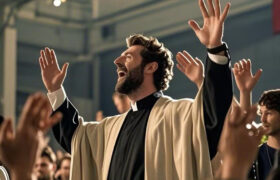没有人比爱德华兹(Edwards)更够资格评估美国的“大觉醒”运动(Great Awakening)了。他从头到都尾亲临其境,亲眼目睹了他所服事的众教会在复兴中情感和身体上强烈的反应。当评论家谴责“大觉醒”纯粹是歇斯底里、病态、疯狂时,他挺身为之辩护;当复兴结束时,他也详细地分析了其消亡的缘由。
爱德华兹的结论是,其实“大觉醒”的朋友们责无旁贷。不是敌人,而是朋友,导致了复兴的消失。
一位爱德华兹传记的作者写到,他相信“大觉醒”逆转的一个主要原因是其朋友的不警醒,他们允许真诚而纯洁的信仰与肉体的“野火”和“热情”如此混为一谈,以致令神的灵担忧,就给撒旦留下了破口。[1] 即便爱德华兹为“大觉醒”辩白,反对其批评者,但同时他也早已承认:一种狂热的情绪正在破坏神在复兴过程中的真实工作。
在1741年的复兴高峰时期,爱德华兹在他写的“神之灵动工的特殊标志”一书中承认:“不慎重、不规范、掺杂的妄想”一直伴随着这场运动。他把这些归咎于“主要是年轻人”,缺乏稳重与经历,在他们热情奔放的青春期,很容易走上极端。[2] 他看清了:失控的激情是鬼魔的工作,它一方面想方设法叫人们保持冷漠、无动于衷;当它办不到时,就反过来“催逼他们热火朝天、走火入魔,从而羞辱上帝。”[3]
爱德华兹(Edwards)写了这些话后不久,到了 1741年的夏天,第一次记录的扑倒、颤抖、狂吼随即爆发了。[4] 当人们开始把这些怪异的现象和圣灵的工作挂上钩时,这些表现就变得更加明显、越发猖獗。默里(IainMurray)写道:一些观察者开始提倡一种观点:即越是惊天动地、鬼哭狼嚎,就越发显明神的荣耀、证明神的能力。一旦这样的观念普及开了,就为各种离谱的事儿敞开了大门……。人们非但不操练节制,反倒放任自己、宣泄情感。[5]
此时,分裂悄悄地渗入了复兴。许多情绪高涨、被灵异现象冲昏了头脑的人,开始拒绝任何人的忠告。虽有牧师警告说:仅是热闹和兴奋并不证明圣灵的工作,但他们反成了众矢之的。智慧的劝诫和善意的提醒,反被误认为是恶意的论断、批评。甚至,提出质疑的敬虔牧者,反被定罪为“没有重生得救”。一群狂热分子开始主导“大觉醒”运动。一位作者指出:“在狂傲、无知和假冒属灵的指导下,虚假的敬虔迅速地扩散开来。”[6]
默里(Iain Murray)总结说:
毫无疑问,“大觉醒”狂热的因素越高涨,属灵的能力就越低落。那些最大声宣告蒙圣灵引导的人,正是那些最消灭圣灵感动的罪魁祸首……。对爱德华兹而言,复兴运动的转折点是当人……不谨慎防备过激的表现。[7]
在爱德华兹写的布雷纳德(David Brainerd)传记中,他对这场复兴的失败做出了评估:
一种过度的、不节制的狂热和某些程度的(属血气的)热情很快地渗入,掺杂在敬虔的复兴当中;在这片土地上,如此普遍性、大规模的复苏,对当时所有的人而言,仍是一件相当新鲜的事儿;无论会众或牧者,都还没学会分辨扎的实信仰和虚假的宗教之间的区别;甚至许多当时德高望重的传道人、多年忠心服事的牧者,都被些光鲜的表面现象一时蒙蔽了。[8]
显然,爱德华兹深信:“大觉醒”不是因关心“神学的正确性”而受压抑的,乃是因容让属灵的偏激而被消灭的,那些最狂热的支持者甚至鼓励过激的表现。没节制的情感宣泄,根本不是复兴最高的属灵成就,反之,正是扼杀复兴的原因。就是这狂热的灵,而非法利赛人的灵,导致了“大觉醒”的衰竭与消亡。
德阿泰加(DeArteaga)明知爱德华兹的结论,却故意视而不见。他违背一切历史的证据,坚持是“教义的正确性”导致了大复兴的衰亡。他说:“尽管爱德华兹有自己的理论,但‘大觉醒’似乎并不是因为它的极端分子而终止,它乃是因为反对者的谴责而结束的。这些定罪的谴责,导致了支持者心灰意冷,更拆毁了众人的信心,以至于他们不再欢迎圣灵的同在了。”[9]
讽刺的是,在德阿泰加(DeArteaga)的书中,当他论及辨别的必要性时,他总结道:“爱德华兹处于极大的劣势,因他没有现成的神学来分辨是非。”其实,根据德阿泰加的说法,“改教家在弃绝整个天主教的神秘神学时,也弃绝了分辨的必要。”[10]
这种对教会历史的荒谬解释,我们不得不提出挑战。首先,爱德华兹当然有一套十分清晰的“分辨神学”。这一点,从他写的“神之灵动工的特殊标志”一书中是显而易见的。若德阿泰加好好地将爱德华兹的分辨方法应用于他的书中就好了,包括他“说有就有”(WordFaith)的神学、“心想事成”(visualization)的技巧、天主教的神秘主义(Catholic mysticism)等等。
再者,德阿泰加所谓的“分辨神学”其实是含糊其辞、不清不楚的。显然,他在暗示,真理客观的标准(圣经和纯正的神学)应该被搁在一边,转而采用纯神秘的方法来辨别。在德阿泰加的理念中,“分辨能力”似乎是一种直觉,一种圣化的本能。
他写道:“虽然分辨力主要是一种属灵(德阿泰加将之等同于“神秘的”)的功能,基于某些圣经的原则,这些原则需要公开地教授。”[11] 然而,这些原则是什么?与“神学的正确性”有什么区别?这些问题,德阿泰加则从不试图去解释。他继续说:
“在最基本的形式上,这样的神学必须被接受:圣灵可以在现今这时代中运行,并且圣灵的运行可以与周围心灵的噪音和恶魔的干扰区分开来。”[12]
我当然相信圣灵在今天仍然运作,并相信他的工作与心灵和恶魔的声音是不同的。爱德华兹也是这么信的,然而在德阿泰加(DeArteaga)的评估中,爱德华兹和我都没有任何“分辨的神学”。[13] 那么到底德阿泰加说的话是什么意思呢?其实,他似乎在说(这正是他书中的主要信息):在灵界中,客观的真理不能成为我们区分何谓真实与何谓虚假的标准。
德阿泰加思想理念中的分辨力是一种神秘的能力。它始于我们“接受圣灵可以在当今时代中运行”[14]。藉此,德阿泰加似乎在表达:我们必须接受神秘现象就是圣灵的工作。之后,圣灵充满的人应该能够本能地作出判断:那些不寻常的现象是否真是圣灵的工作。既然“神学的正确性”是一个预先被排除在外的识别标准,那么我们必须假定辨别的主要标准是主观的。德阿泰加书中的信息,从头至尾都肯定了:其实这就是他的意思。
但这并不是神学的分辨,乃是直达灵性混乱的高速公路。正如我们反复看到的:分辨与智慧是息息相关的,这是圣经认知和圣灵教导的一种理性功能,不是一种感觉,更不是一种“第六感官”;辨别能力完全取决于对圣经正确的理解,就是德阿泰加术语中的“神学的正确性”,但他既已否定这一切为法利赛主义,就已丧失了真正的辨别能力。
最终我要说:我们若忽略了爱德华兹对十八世纪“情感过激”的判断,今日就要自遭亏损。每当情感泛滥的乱象出现于教会之时,德阿泰加(DeArteaga)随意地改编历史,给了人们一种学术上可信的假象。对“大觉醒”任何情感方面的关注,过于其神学大能的传讲,其实是开了一副属灵毁灭的药方。好,我们下次再考虑它现今所结出的果子。

 (改编于“鲁莽的信心”)
(改编于“鲁莽的信心”)
————————————–
Jonathan Edwards Warns Modern Mystics
by John MacArthur
Monday, November 12, 2018
No one was in a better position to evaluate the GreatAwakening than Jonathan Edwards. He watched it firsthand from beginning to end.He personally witnessed the remarkable emotional and physical responses incongregations where he preached. He defended the Awakening when criticsdenounced it as pure hysteria. And when it was over, he carefully analyzed thereasons it died out.
Edwards concluded that it was, in fact, the friends ofthe revival, not its enemies, who were responsible for its death. Onebiographer of Edwards has written,
He came to believe that there was one principal cause ofthe reversal, namely, the unwatchfulness of the friends of the Awakening whoallowed genuine and pure religion to become so mixed with “wildfire” and carnal“enthusiasm,” that the Spirit of God was grieved and advantage given to Satan.[1]
Edwards, even while defending the Awakening against itscritics, had long acknowledged that a strain of fanaticism was undermining thetrue work of God in the revival. In The Distinguishing Marks of a Work of theSpirit of God, written in 1741 at the height of the revival, Edwardsacknowledged that “imprudences, irregularities, and [a] mixture of delusion”had attached themselves to the movement. He attributed these things to “chieflyyoung persons . . . who have less steadiness and experience, [who] being in theheat of youth are much more ready to run to extremes.” [2] He saw runawaypassions as the work of the devil, who tries to keep people apathetic as longas possible—then when he is no longer able to accomplish that, “endeavours todrive them to extremes, and so to dishonour God.” [3]
In the summer of 1741, soon after Edwards wrote thosewords, the first recorded outbreaks of faintings, shakings, and outcries began.[4] The manifestations grew more pronounced as people began to associate theSpirit’s work with these bizarre sensations. Iain Murray writes that someobservers
began to encourage the idea that the greater the outcriesand commotion, the more glorious was the evidence of God’s power, and once thisidea was accepted the door was open to all manner of excess. . . . Far fromattempting to restrain themselves, people sometimes willfully gave way to sheeremotion. [5]
At this point division crept into the revival. Many whowere swept up in the emotion and excitement of the phenomena began to distrustany voice of caution. Pastors who warned that mere noise and excitement were noproof of the Spirit’s working often found themselves the targets of backlash.Wise words of friendly caution were discarded as if they were hostilecriticism. Godly pastors who raised concerns were even labeled unconverted. Afaction of fanatics began to commandeer the Awakening. One author noted “therapid progress of a spurious religion, under the guidance of pride, ignorance,and spiritual quackery.” [6]
Iain Murray concludes,
Without question, the rise of the fanatical elementcoincided with the decline of the spiritual power of the Awakening. Those whospoke most loudly of being led by the Spirit were the very persons responsiblefor quenching the Spirit’s work. . . . For Edwards the turning point in therevival came when men . . . failed to guard against excesses. [7]
In his biography of David Brainerd, Edwards gave his ownassessment of the revival’s failure:
An intemperate imprudent zeal, and a degree of [fleshly]enthusiasm soon crept in, and mingled itself with that revival of religion; andso great and general an awakening being quite a new thing in the land, at leastas to all the living inhabitants of it; neither people nor ministers hadlearned thoroughly to distinguish between solid religion and its delusivecounterfeits; even many ministers of the Gospel, of long standing and the bestreputation, were for a time overpowered with the glaring appearances of thelatter. [8]
Clearly Jonathan Edwards believed the Great Awakening wasquenched not by concerns for “theological correctness” but by spiritualextremism that was tolerated and even encouraged by the revival’s mostenthusiastic supporters. The unbridled emotional excesses, far from being thesupreme spiritual achievement of the revival, were the very thing that killedit. It was fanaticism, not pharisaism, that ended the Great Awakening.
William DeArteaga is aware of but refuses to acceptEdwards’s conclusion. Against all the historical evidence, DeArteaga insiststhat “doctrinal correctness” led to the revival’s demise:
In spite of Edwards’s own theories, it seems that theGreat Awakening was not quenched because of its extremists. It was quenchedbecause of the condemnation of its opponents. This condemnation demoralized thesupporters and marred the faith of the public to the point where they no longerwelcomed the presence of the Spirit. [9]
Ironically enough, at this point in DeArteaga’s book hespeaks of the need for discernment. He concludes that “Edwards was at atremendous disadvantage [because] he had no readily available theology ofdiscernment.” In fact, according to DeArteaga, “the Reformers rejected the needfor discernment when they threw out the whole of Catholic mystical theology.”[10]
This astonishing interpretation of church history mustnot be allowed to go unchallenged. In the first place, Edwards did have a veryclear-cut “theology of discernment.” This is evident in the clarity of his workThe Distinguishing Marks of a Work of the Spirit of God. DeArteaga would dowell to apply Edwards’s prescription for discernment to many of the ideas hedefends in his book, including Word Faith theology, visualization techniques,and Catholic mysticism.
In the second place, what DeArteaga means when he speaksof “a theology of discernment” is not altogether clear. Apparently he issuggesting that objective criteria of truth—Scripture and sound theology—shouldbe laid aside in favor of a purely mystical approach to discernment.“Discernment” in DeArteaga’s scheme seems to be nothing more than intuition—asanctified gut reaction.
He writes, “Although discernment is principally aspiritual [DeArteaga equates this with mystical] function, it is based oncertain biblical principles which must be taught publicly.” [11] Whatprinciples these are and how they differ from “theological correctness,”DeArteaga does not attempt to explain. He continues,
In its most basic form such a theology must accept thatthe Holy Spirit can operate in the current age and that the Holy Spirit’soperations can be discerned from the surrounding noise of psychic and demonicinterference. [12]
I certainly believe that the Holy Spirit operates todayand that His operations are distinguishable from psychic and demonic noise. Edwardsbelieved that too. But in DeArteaga’s assessment, neither Edwards nor I haveany “theology of discernment.” [13] So what does DeArteaga mean by thisstatement?
What he actually seems to be saying (indeed, it is themain message of his book) is that objective truth cannot be the standard bywhich we discern between what is true and what is false spiritually.Discernment in DeArteaga’s scheme is a mystical ability. It begins when we“accept that the Holy Spirit can operate in the current age” [14]—and by thisDeArteaga seems to mean that we must accept mystical phenomena as the work ofthe Spirit. Then the Spirit-filled individual is supposed to be able to tellinstinctively whether unusual phenomena are truly the work of the Holy Spirit.Since “theological correctness” is a priori ruled out as a standard fordiscernment, we must assume that the criteria for discerning are predominatelysubjective. The front-to-back message of DeArteaga’s book affirms that this isin fact what he means.
But that isn’t a theology of discernment; it is a sureroad to spiritual confusion. As we have seen repeatedly, discernment is relatedto wisdom. It is a function of the biblically informed and Spirit-taughtintellect. It is not a feeling or a “sixth sense.” Discernment is utterlydependent on a right understanding of Scripture—“theological correctness” inWilliam DeArteaga’s terminology. But having attacked all that as pharisaism, hehas ruled out true discernment.
Ultimately, we ignore Edwards’s assessment of eighteenthcentury “emotional excesses” to our own modern peril today. DeArteaga’sconvenient historical revisionism has given an air of academic credibilitywherever emotion-based anarchy manifests itself in churches today. Any focus onthe emotional aspects of the Great Awakening at the expense of its powerfultheological preaching is a recipe for spiritual disaster. And we’ll considerthe present-day fruit of that next time.


(Adapted from Reckless Faith)

 微信扫一扫订阅
微信扫一扫订阅


